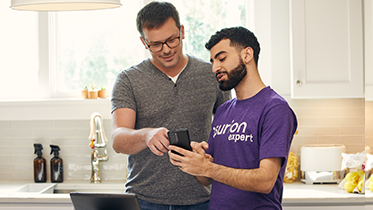It's perfectly normal to feel a bit of panic if your refrigerator is too warm; especially if you've been keeping some tasty perishables cooling in there. So if you reach into your fridge and find that it just isn't as cold as it used to be, you may find yourself wondering why.
Asurion Experts are repair pros familiar with all of your home's major appliances so they know exactly how to fix your refrigerator-related issues. Keep reading for an expert explanation of common causes for a refrigerator that's too warm, or skip ahead a bit for our step-by-step guide to troubleshooting this common issue.
Troubleshooting a refrigerator that's not cooling
Worried about your food spoiling and not sure what steps to take next to fix your warm fridge? Start by working your way through these expert steps one-by-one until you figure out the issue—or reach out to a refrigerator repair technician for assistance.
Make sure the temperature setting isn't too high
Check that the temperature setting is set appropriately. If it's too warm, gradually set it cooler until your fridge is the appropriate temperature.
Remove anything blocking the circulation vents
Make sure that nothing is blocking any of the circulation vents, and that air can freely circulate within the refrigerator.
Keep enough food in your fridge
If your fridge is empty, fill up some space with jugs of water to help maintain the temperature.
Check for an old or cracked gasket seal
Take a look at the gasket seal. If it seems dry, line it with a layer of petroleum jelly. If the seal is damaged, replace it.

Psst... Got 2 minutes?
That’s how long it takes to get a care plan personalized for you:
✓ Coverage for thousands of devices ✓ Fast, quality fixes
✓ Hands-on help when you need it
Clean the condenser coils
Remove the underplate or back plate from your refrigerator and use a vacuum to remove excess dust and dirt from the condenser coils. Do this at least twice a year—more often if you have pets who shed.
Inspect the evaporator fan motor for clogs or damage
Unplug your fridge, then locate the evaporator fan—you can typically find it behind the freezer wall. Take off the fan cover and check for any clogs due to debris or ice. You should also check for any damage or looseness in the evaporator fan blades. Manually spin the fan to see if the motor shaft turns properly.
Ensure the condenser fan motor hasn't stopped
With your refrigerator unplugged, locate the condenser fan motor, usually on the bottom back of the fridge, and take off the access panel. Check to see if the fan can move freely, and remove any debris that may be blocking the fan blades. Also, check for any wear and tear on the fan. If there are any physical issues, you'll need to replace it. The condenser fan motor can also be checked for any electric supply issues using a multimeter, if you know your way around electrical work. If not, we recommend reaching out to a fridge repair expert for help.
Check that the electronic control board is functioning properly
The electronic control board is the brain behind your fridge's operation, so if it's damaged, you've got problems. To find where the electronic control board is located on your refrigerator, check the owner's manual or manufacturer's website. Once located, while your fridge is disconnected from the power, inspect the control board for any signs of damage, such as burnt connections. If any exists, you'll want to refer again to the fridge's manual or the manufacturer’s website for further instructions on how to replace the board.
Look to see that the temperature sensor is calculating the correct temperature
Ensure that the temperature sensor bulb or wires are in the proper place and are undamaged. You can consult your owner's manual to determine the diagnostics for your particular refrigerator, or check the manufacturer's website. You can also test it with a multimeter to check continuity—again, this should occur while your appliance is unplugged. Check out our guide to using a multimeter for appliance repair if you need help.
My fridge isn't working, but my freezer is. What's going on?
The most common reason for a refrigerator not cooling while its freezer is still working properly is a problem with the defrost system. The defrost system involves multiple components; if any of these malfunction, it can result in the refrigerator not getting cold, even though the freezer is still working. The good news? If your refrigerator is warm but your freezer works, the troubleshooting steps are the same as the ones we've already covered.
When to call a professional
When your refrigerator isn't cold enough, not only do you have to worry about food spoiling, but you're wasting energy, too, since your fridge has to constantly work overtime. So if you've done all you can to troubleshoot the problem and your refrigerator is still too warm, it might be time to call a refrigerator repair professional.
Reliable protection for the major appliances you rely on
When your appliances don't work, we do. With Asurion Appliance+®, you get hassle-free coverage and 24/7 troubleshooting support for your current and future appliances—no matter the brand or where you bought them. But it’s not the only care plan we offer. Take our 2-minute quiz to find the right care plan for your appliances and tech, or learn more about how you can get total peace of mind with Asurion Appliance+.




